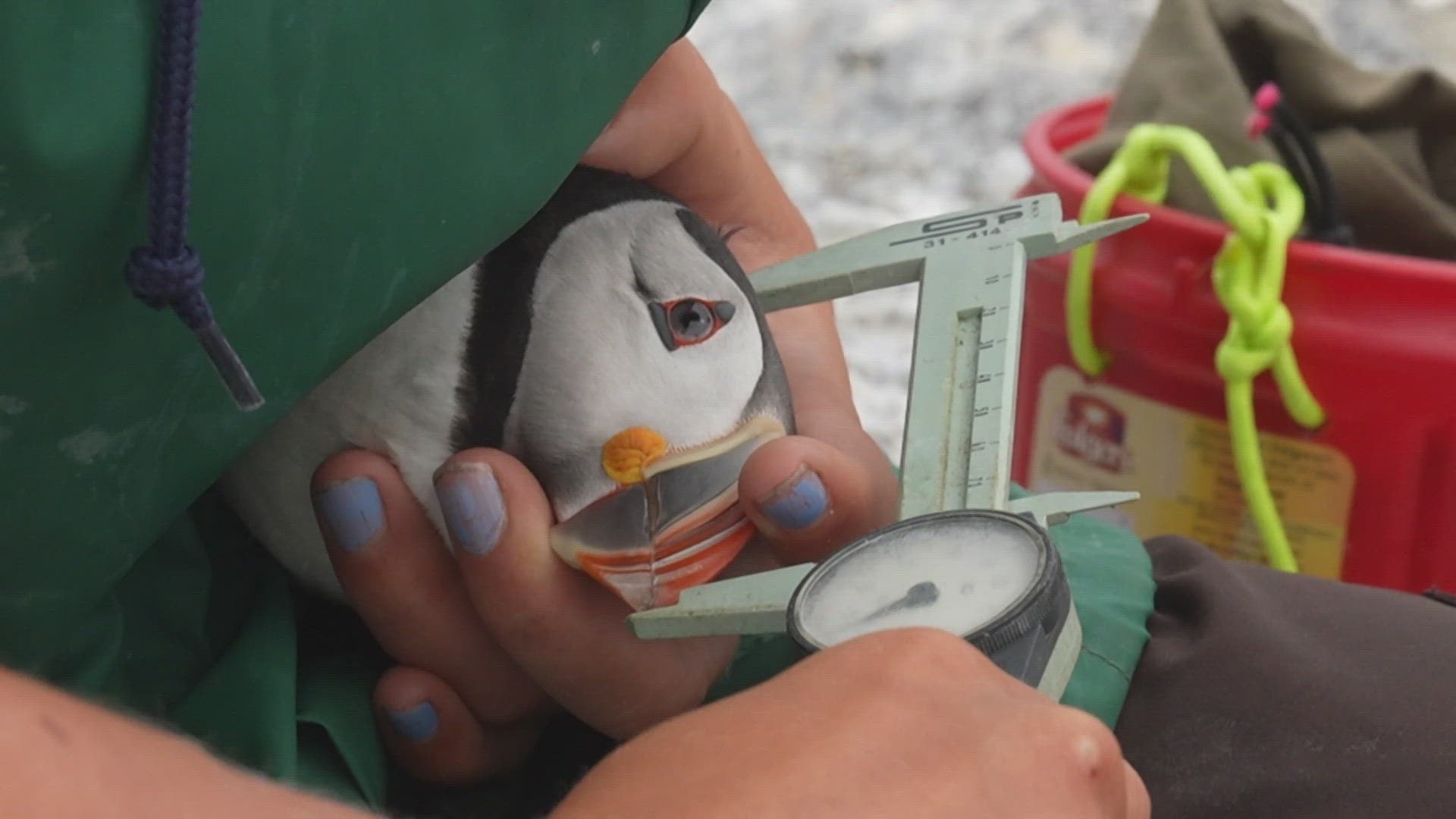BREMEN, Maine — In the quiet midcoast town of Bremen, I hopped on a boat with Don Lyons, the director of conservation science at the Audubon Seabird Institute.
Seven miles out, into the fog, a tiny island came into view—as did a greeting party.
Lyons moored our boat offshore as research assistant Arden Kelly paddled a minuscule inflatable to collect us one at a time.
I thanked her for her hard work once we reached the island—Eastern Egg Rock—though she and her three Audubon research colleagues seemed happy to have company; because the locals can be a bit much, as they say.
Birds swooped overhead in indiscriminate flight patterns; most of them terns.
"Hoods up," Kelly instructed as we began walking, and she meant it. Her own hood and back were covered in dried bird droppings.
"They aim really well," she added, gesturing up to the terns.
The squawk of a tern is about as friendly as a police siren and, unlike its intestinal contents, seemingly limitless.
"Oh man, the noise is tough," Kelly exhaled when I brought it up. "And the birds do not quiet at night. It is loud 24/7."
Despite this work environment, birds are why the team of four was there—gladly signing up to live in small tents on that rock from May through mid-August to study a most peculiar-looking Maine species: puffins.
Lyons, Kelly, and I sat in a small wooden blind and watched the spectacle. Dozens bobbed together on top of nearby waves—an effort called "rafting." Dozens more waddled awkwardly between ledges or sunbathed next to terns; their iconic orange beaks moving left or right as they scanned for predators.
More than 400 puffins migrate there each spring to find lifelong mates and reproduce. They are expert swimmers, frantic flyers, and they're a serious tourist attraction. We watched a puffin cruise boat out of Boothbay Harbor pull up close to shore, allowing dozens of onlookers to gaze through binoculars and camera lenses.
But scenes like this were almost lost forever, as Lyons pointed out.
"Puffins were absent from this island, perhaps, for as much as 100 years, from the late 1800s until 1973," he explained. "When Audubon began a restoration program and brought the first puffling chicks—pufflings—down from Canada."
Humans hunted puffins off the island. Now, under Project Puffin, these people protect and study a healthy colony. In fact, they seem to be one with the place. The team's presence keeps predators like eagles away, and some strange things happen.
As Kelly led me down a narrow path, she bent over and scooped up a gull chick—screaming, but adorable and otherwise unharmed. She gently placed it away from the trail and began moving along as if she had retrieved the morning paper.
"How often does that happen," I inquired, shaking my head.
"Oh, often," she chuckled and kept walking.
Back in our blind, I watched as Kelly's colleague Camryn Zoeller sat in a nearby blind, holding a long string that attached to the top of a wooden box, sitting roughly three feet above the rocks.
A puffin seeking a higher perch flew down and landed on it. Zoeller yanked the string, a trap door opened, and the bird helplessly flapped as it dropped to a pillow at the bottom.
The team catches and carefully tags the puffins, so Audubon and other agencies can keep tabs on the populations as they migrate to Maine in May and back east in August. They also take some measurements, and then, it's time for an awkward goodbye.
Puffins are quite dense, Zoeller explained. Pair that with their relatively small wings, and they cannot generate enough lift to fly straight up.
So, Zoeller walked to the edge of a ledge, bent down, and "granny-tossed" the puffin high into the air; its frenetic flapping keeping it just high enough in the air for it to begin gliding away.
"Honestly, the best part of the job," Zoeller said. "I love it so much."
That statement would soon be challenged, as she fetched a puffling from a burrow nearby to check on its health. The young bird was only a week or two away from fledging, but still soft and grey and not resembling the technicolored adults.
The team has noticed earlier puffling births, as they adapt to climate change. There are challenges ahead for the part-time residents of Eastern Egg Rock, but the team believes this habitat is a success story worthy of optimism.
"With a little hard work and dedication, and a little elbow grease and a little love, and maybe not caring about bird poop so much, [we] can really provide the results to show that our dedication can make a difference, in terms of conservation," Arden Kelly said, holding the puffling. "And that projects that take initiative, like this one, can lead to beautiful things and lots of furry, happy, plump babies."

